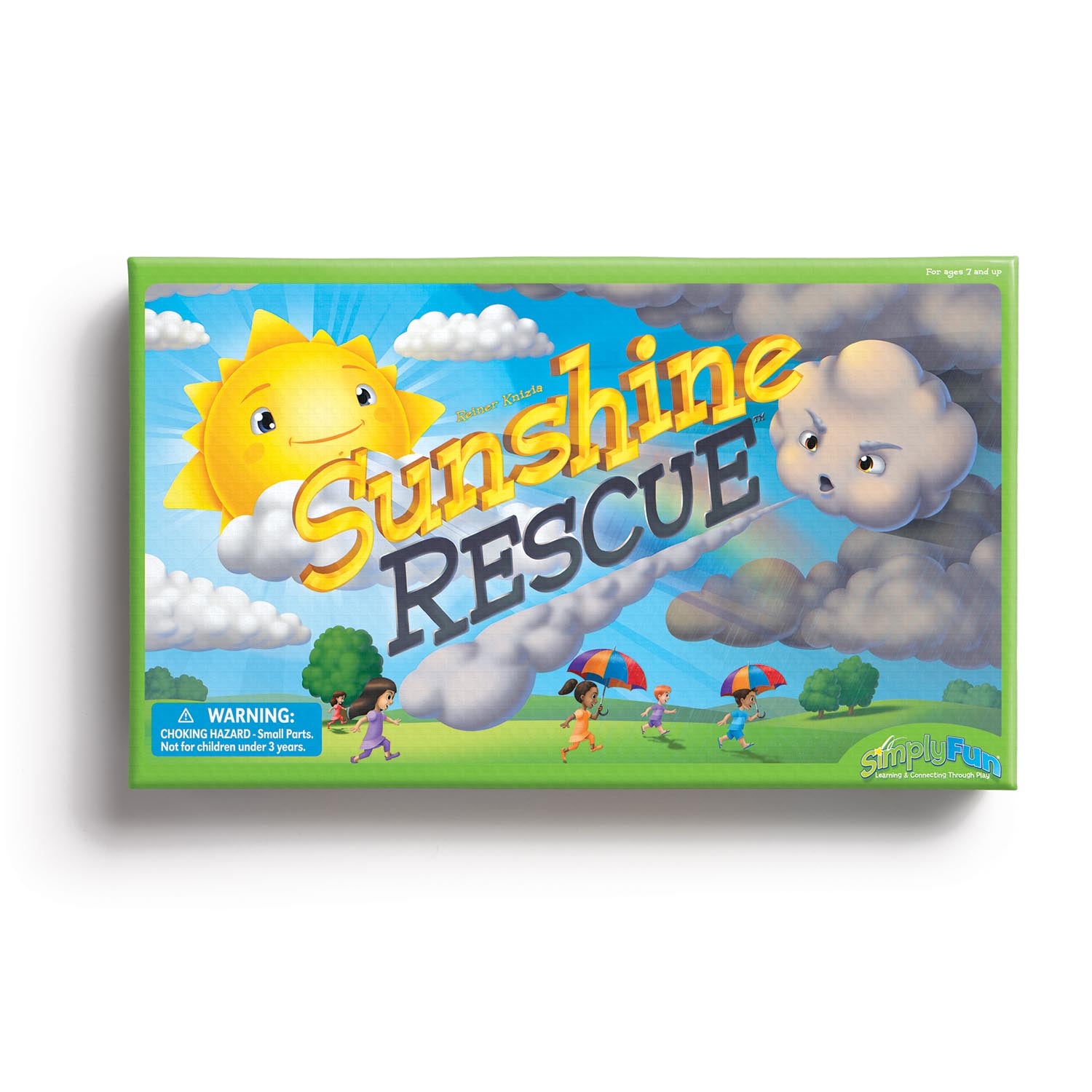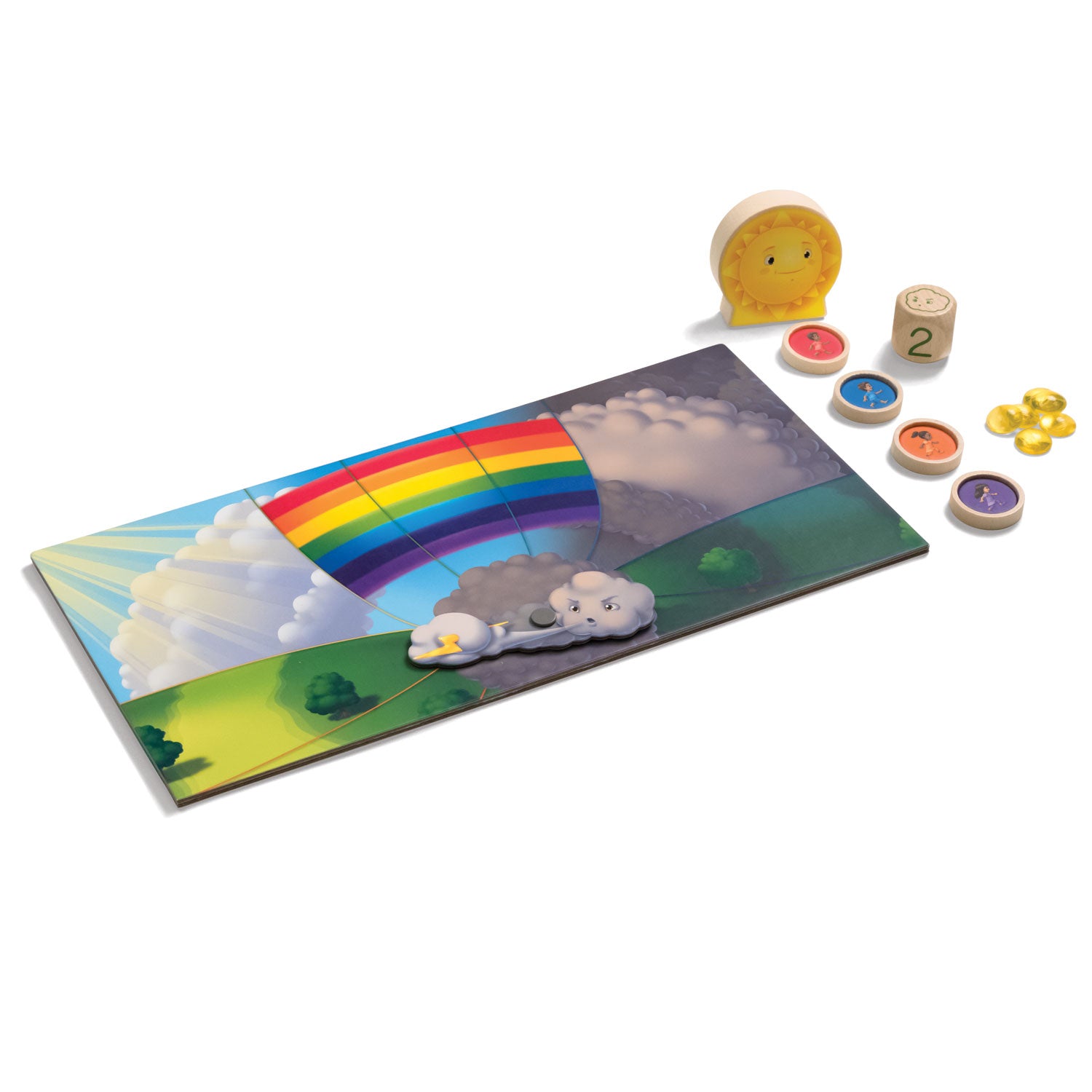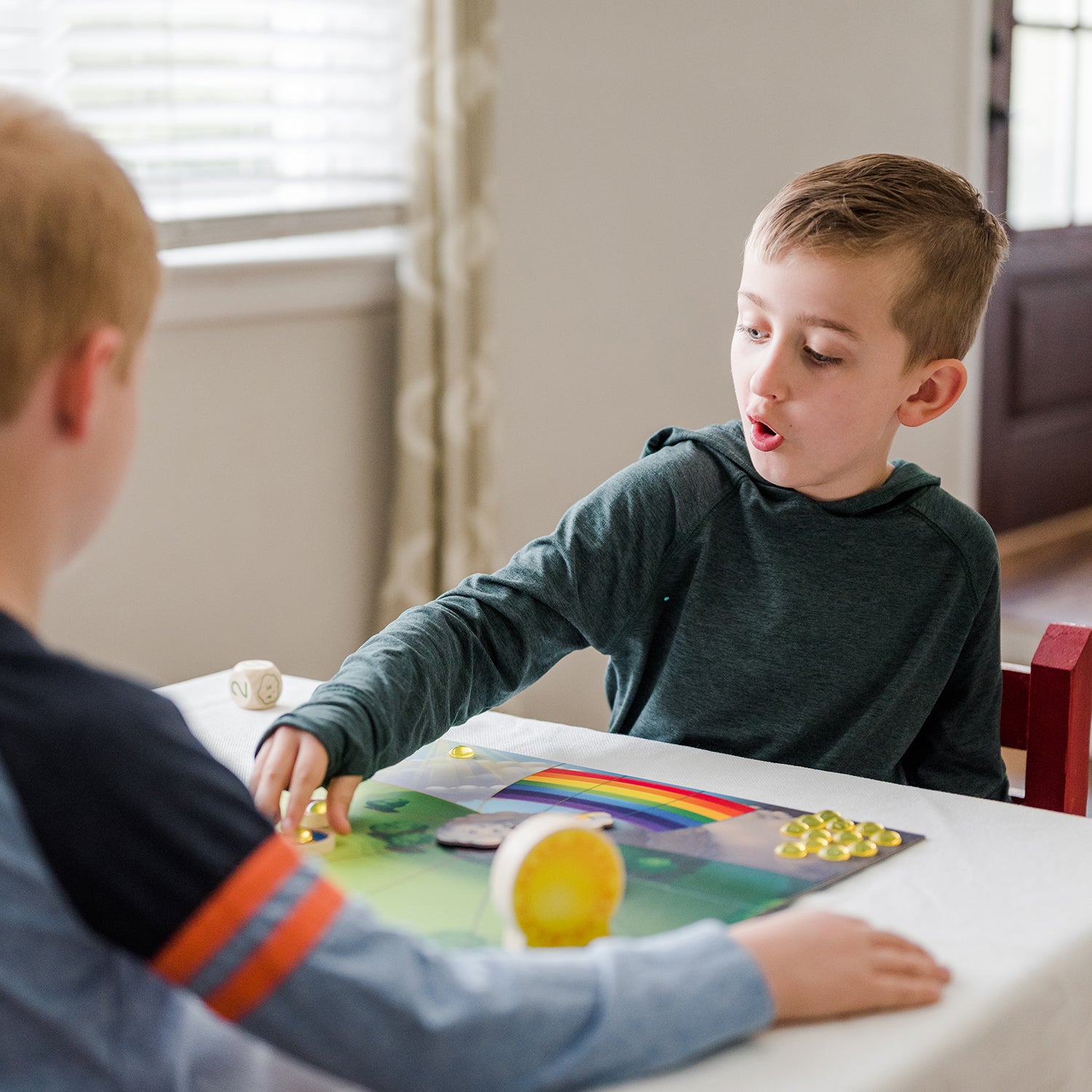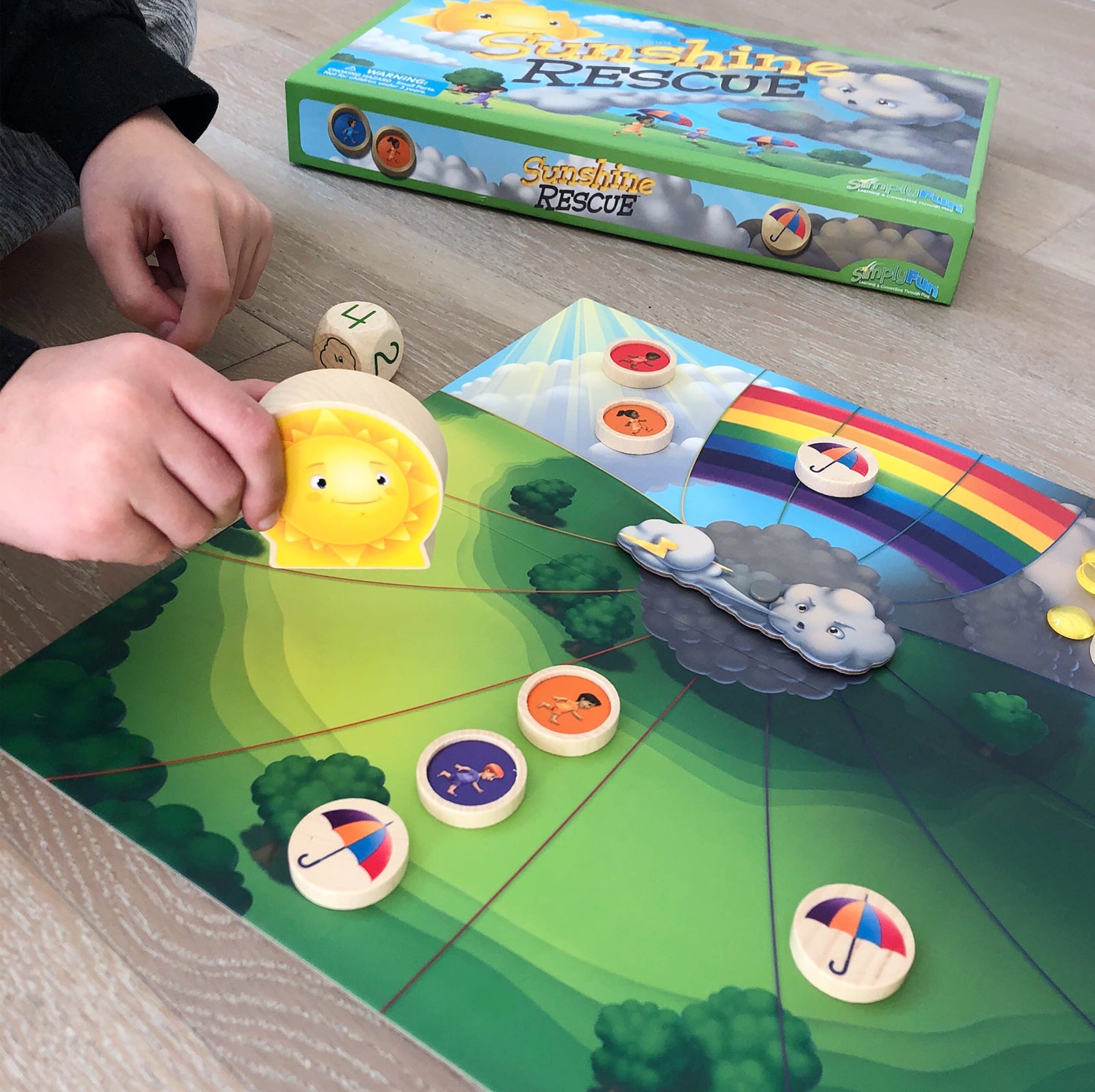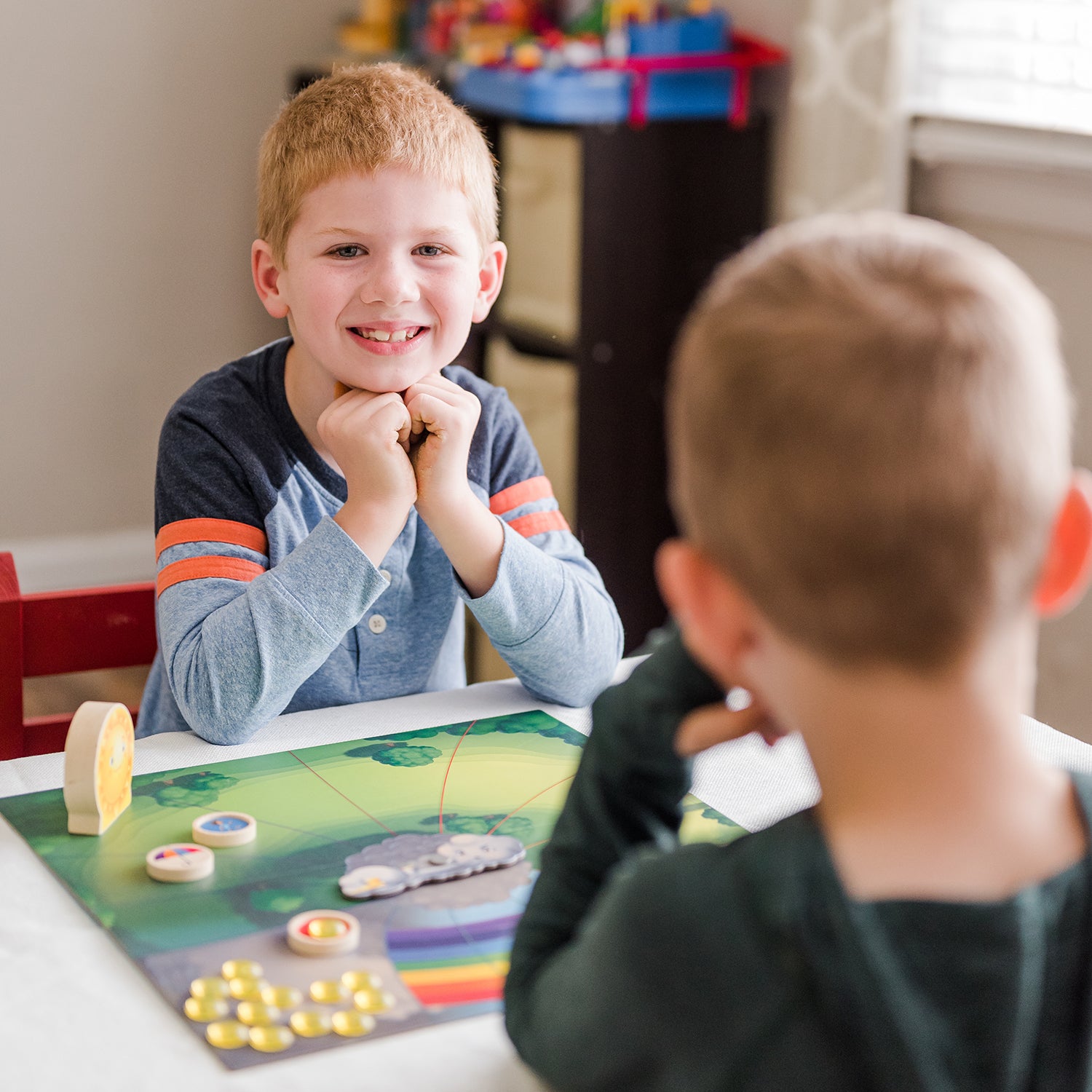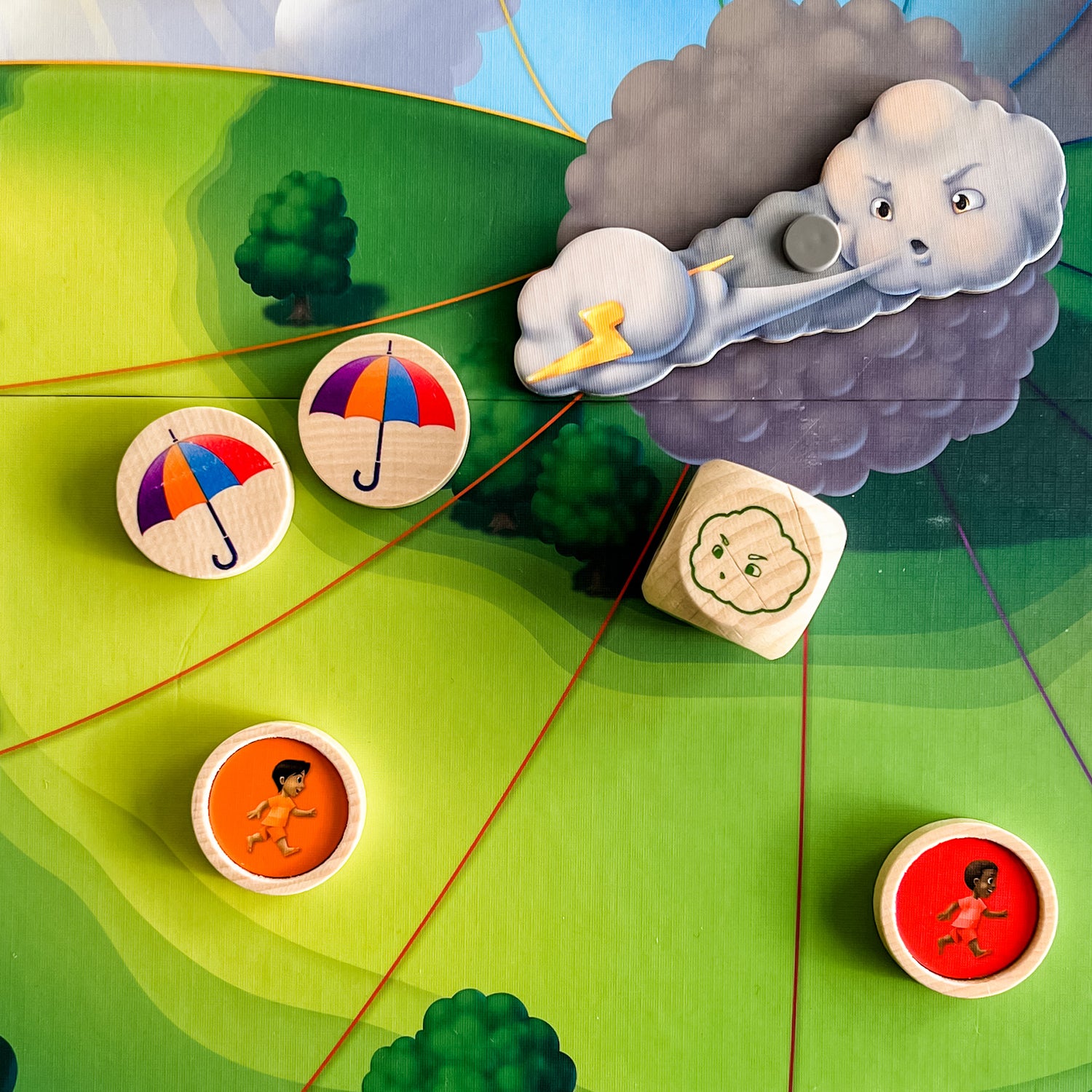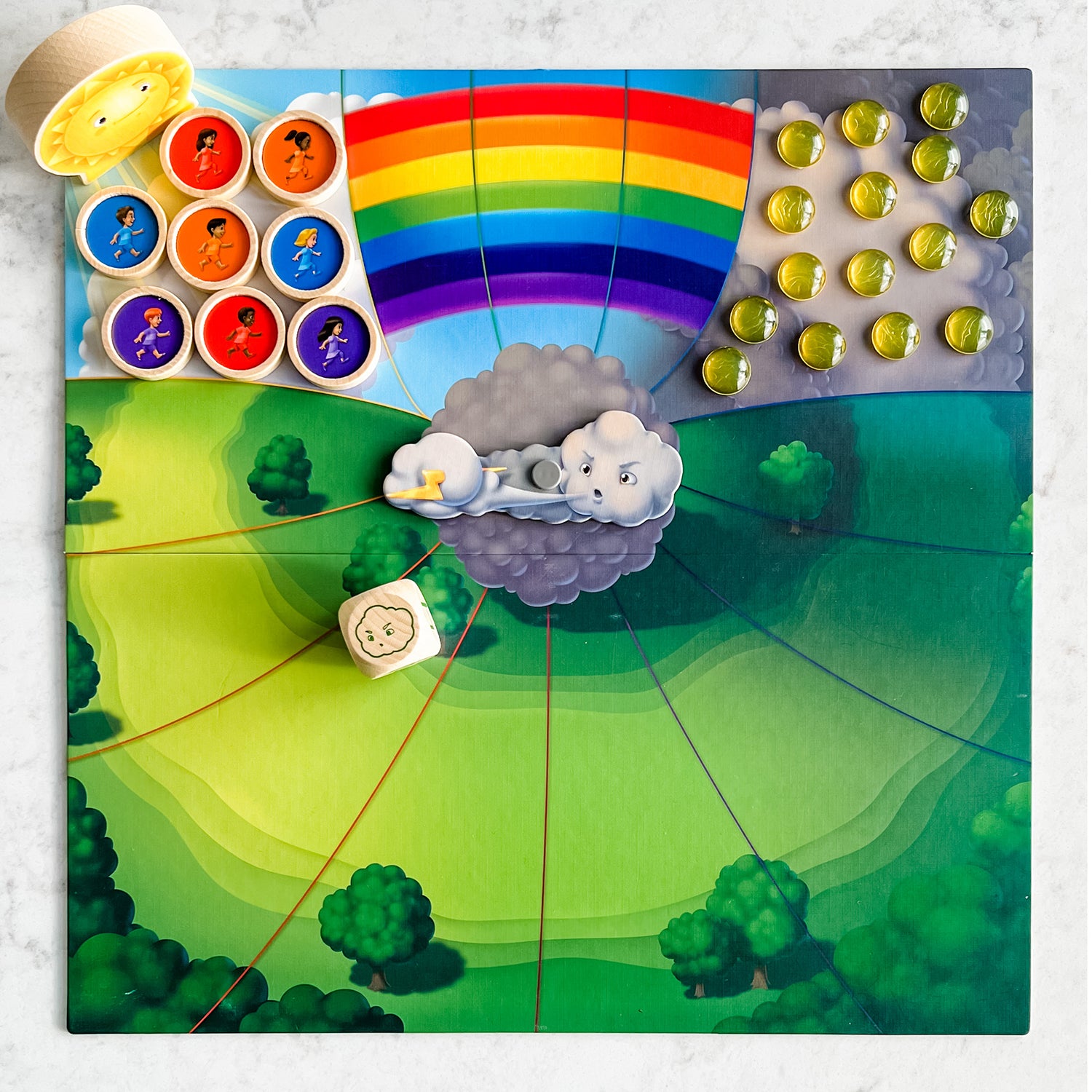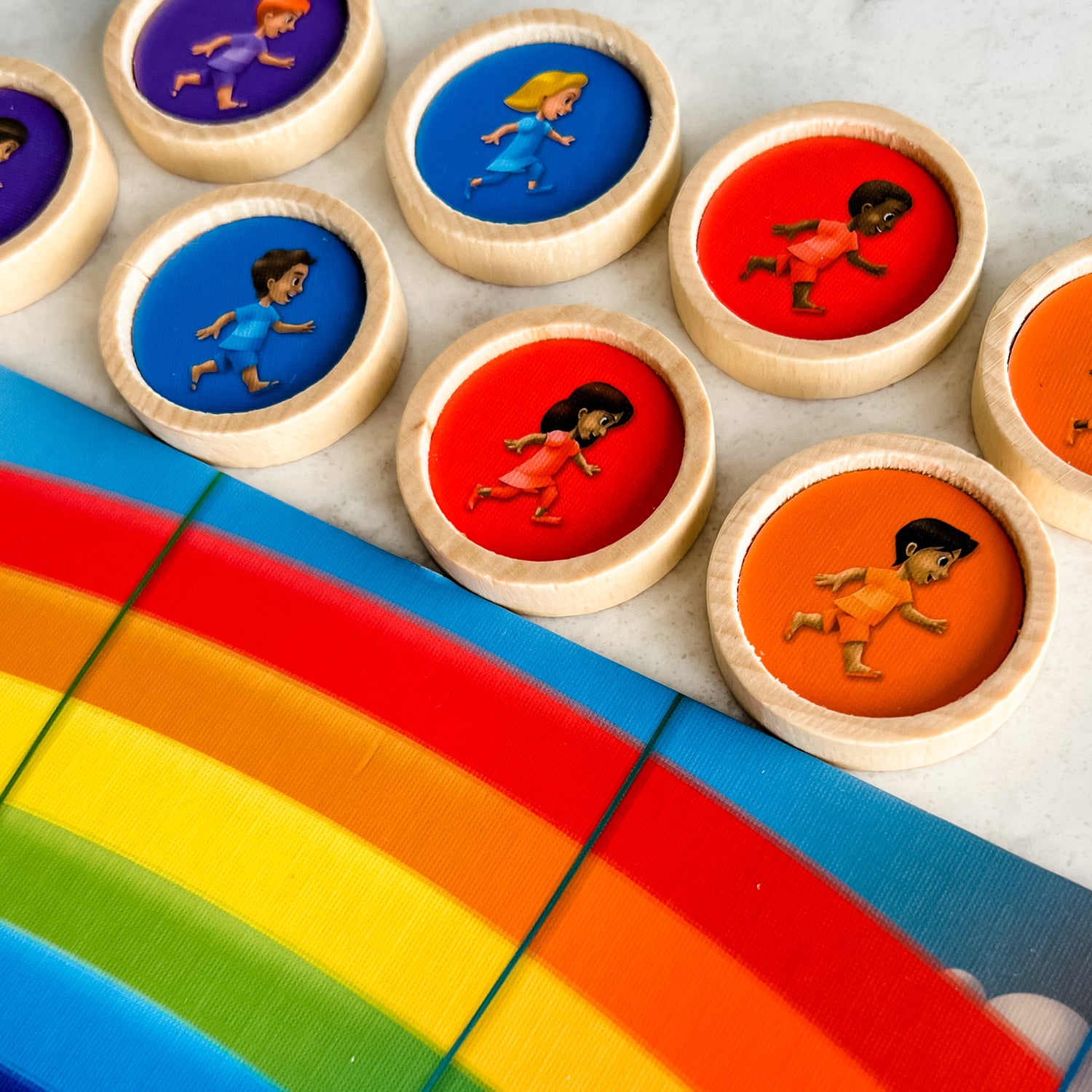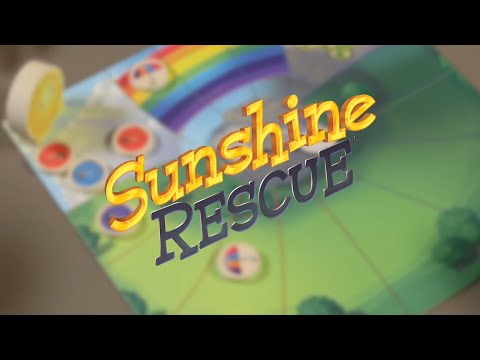Sunshine Rescue
Sunshine Rescue
2-4 players • 30 minutes • 7 & up
Focus: Decision Making
Couldn't load pickup availability
In this game that builds good decision making skills, children skip through the field or take the rainbow shortcut to try and rescue pieces of sunshine. Watch out as the storm cloud spins; if it points at a child they must hide under their umbrella until the sun can rescue them. The first player who brings back three pieces of sunshine wins the game.
Skills: Decision Making, Achieving Goals
Game Includes
Game Includes
- 8 Children (4 pairs)
- 1 Sun
- 15 Pieces of Sunshine
- 1 - 6 sided die
- 1 Gameboard with Storm Cloud Spinner
- 1 Rules Booklet
Share
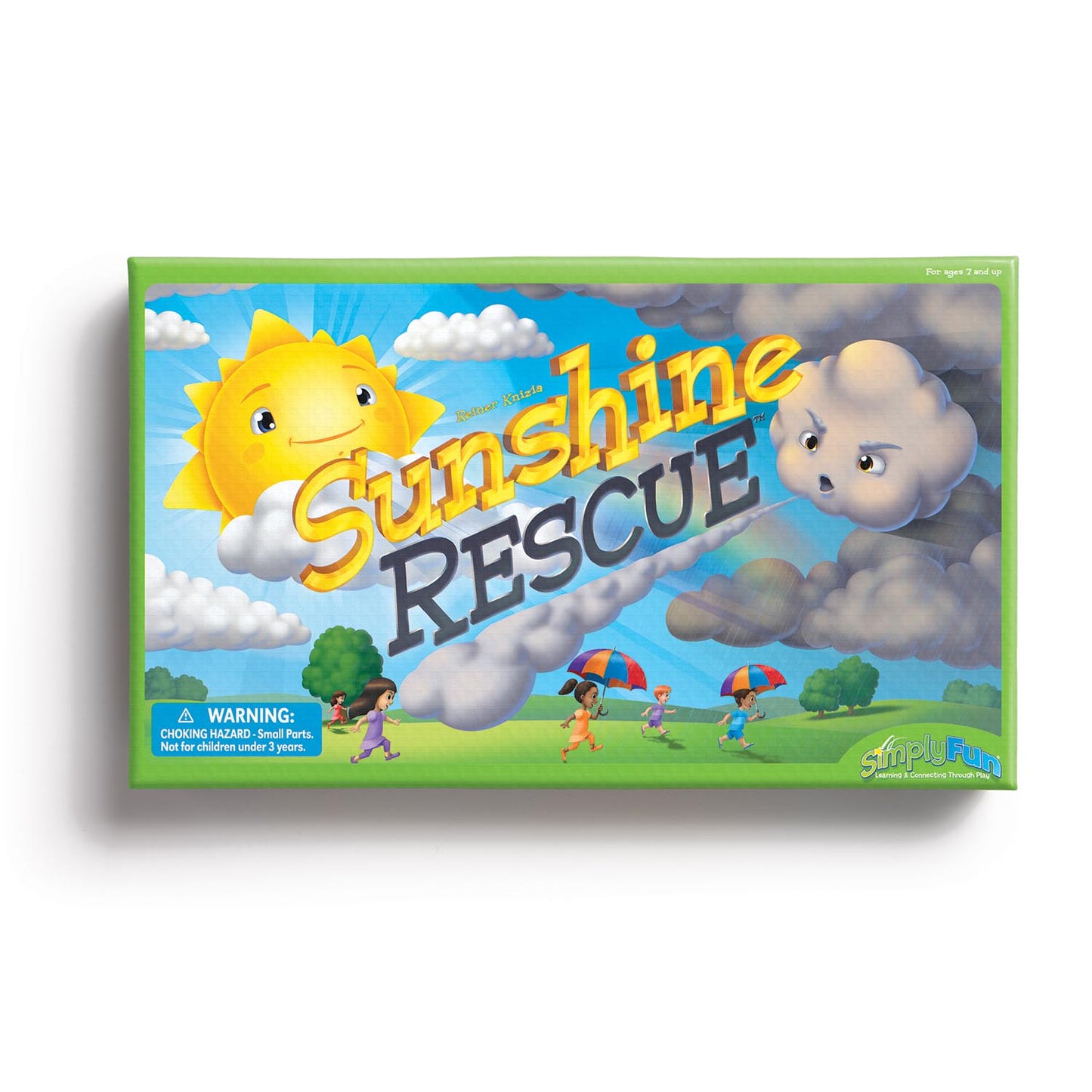
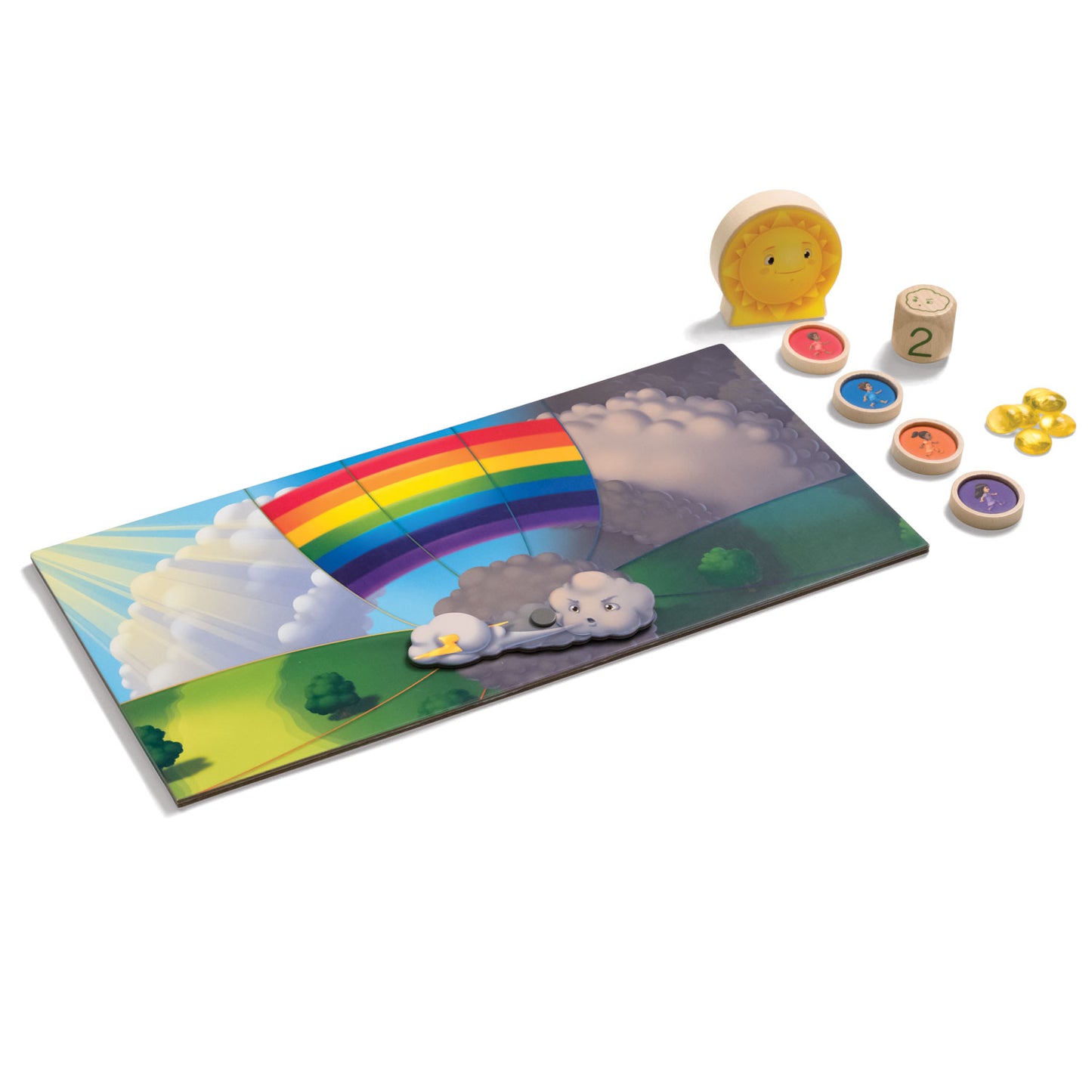
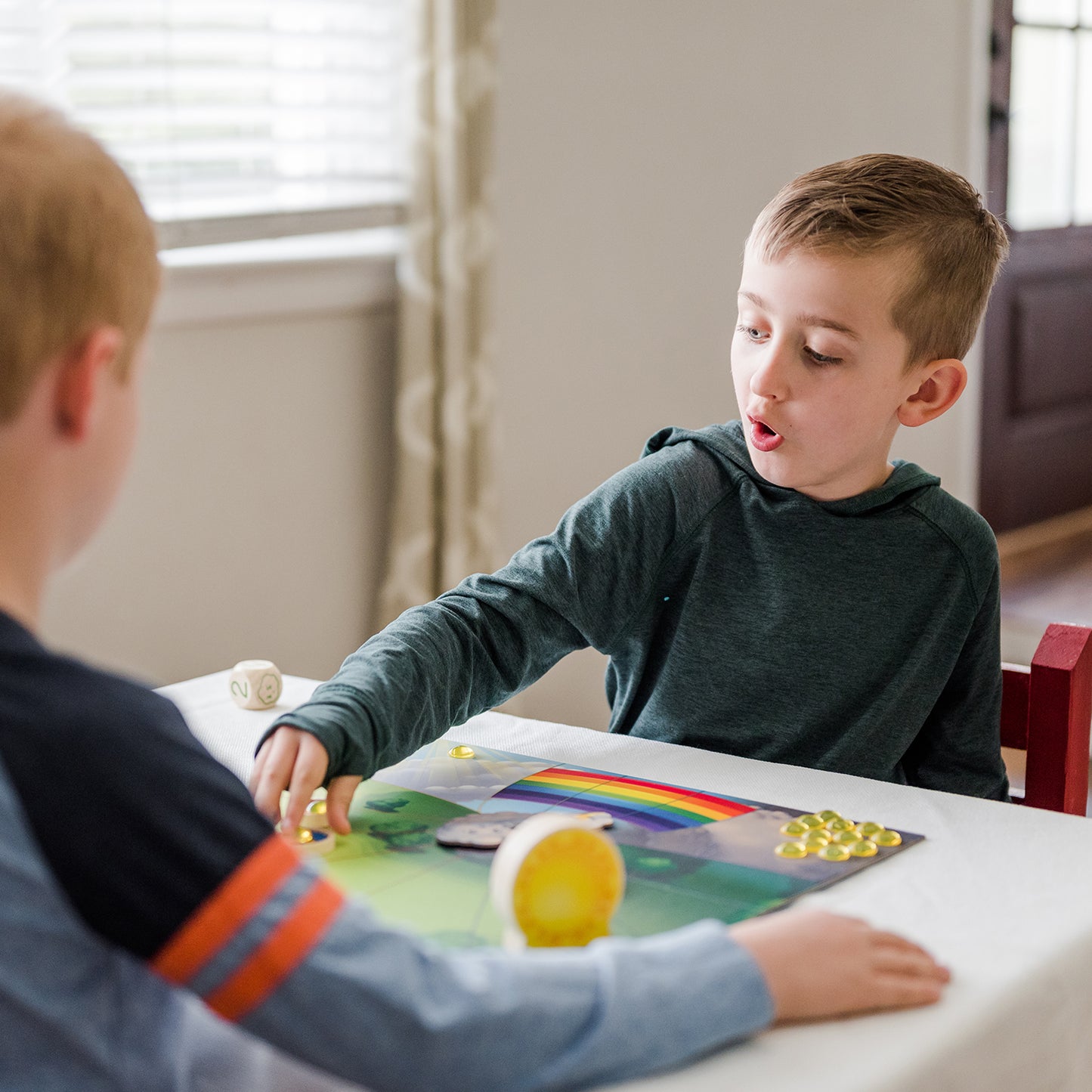
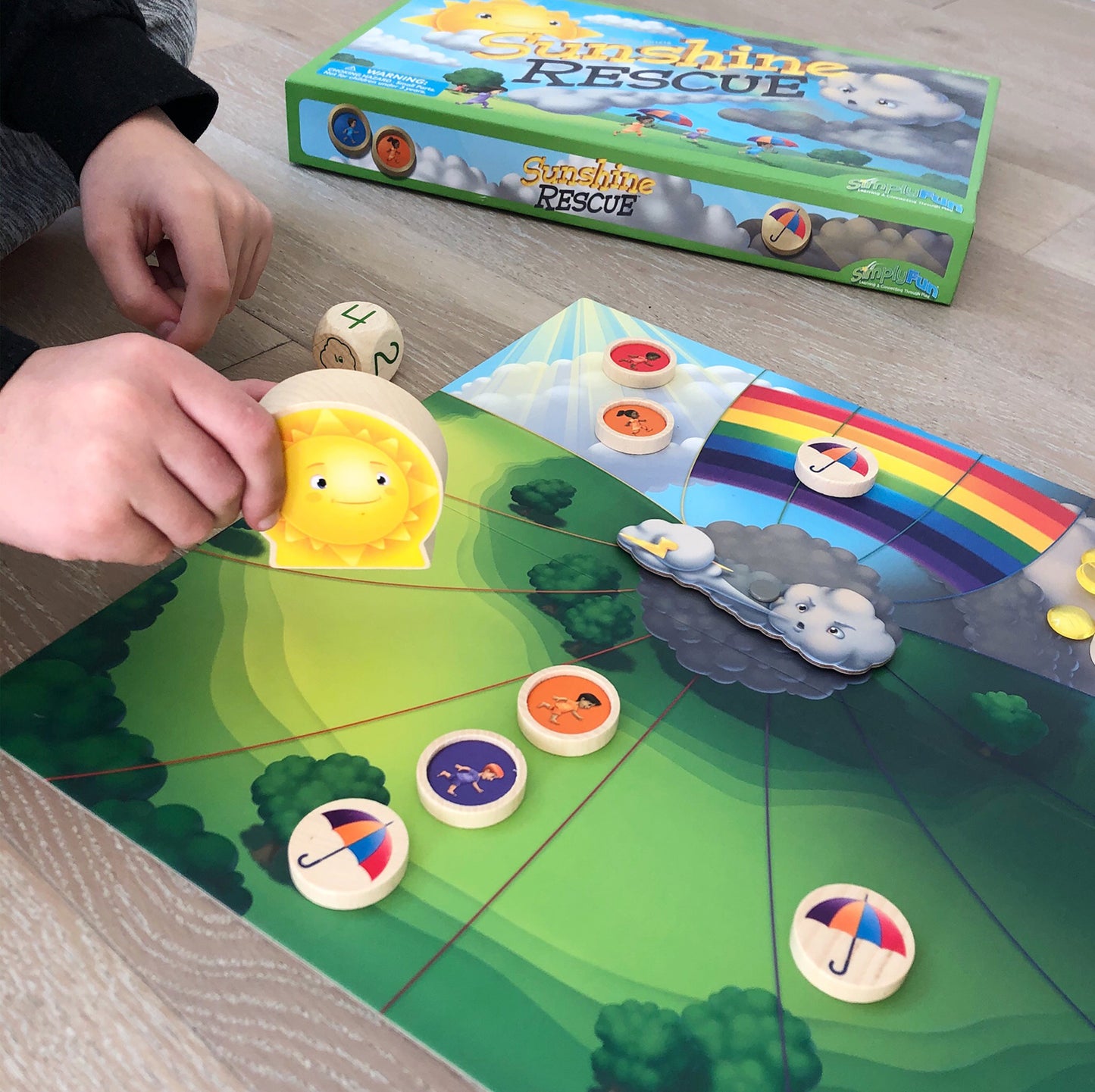
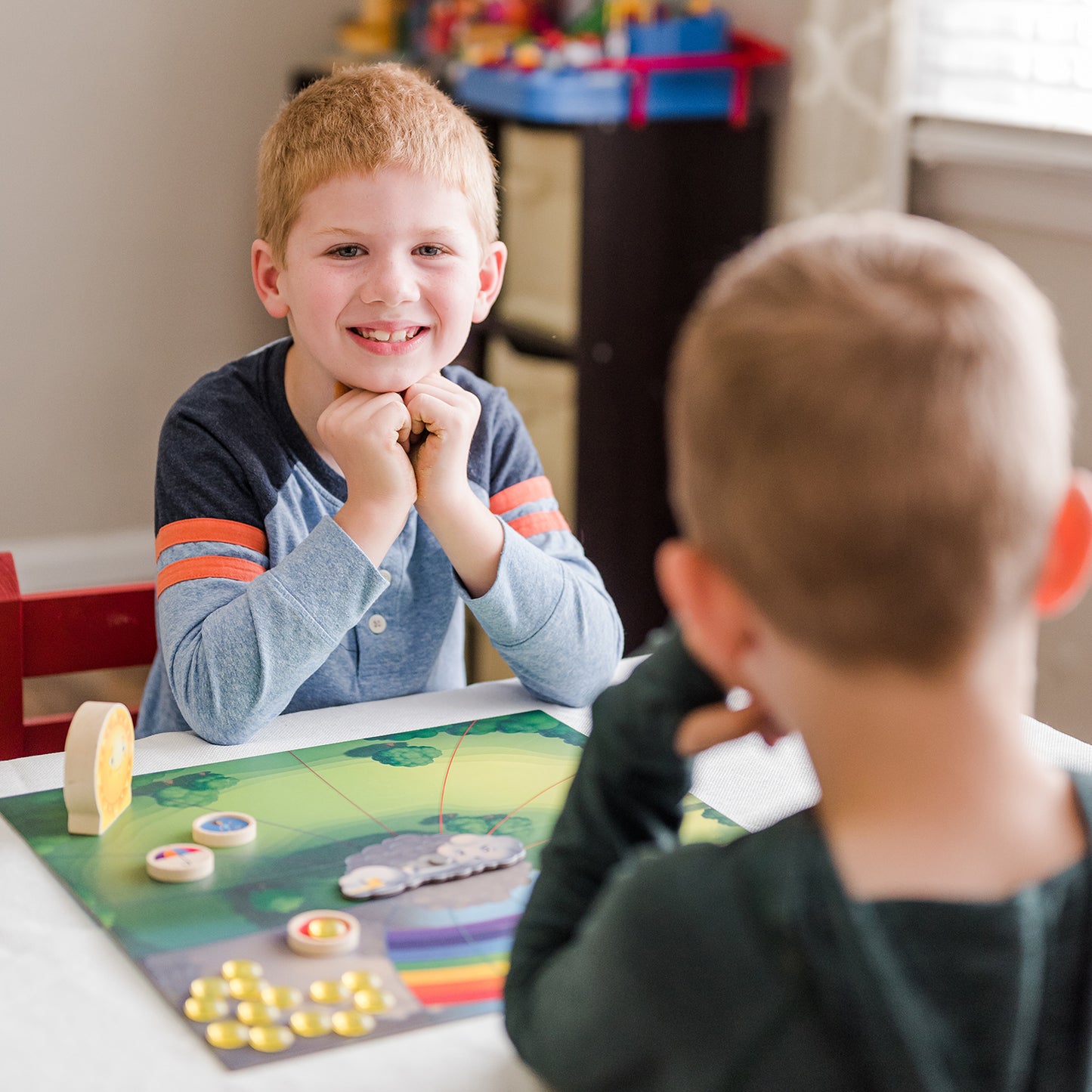
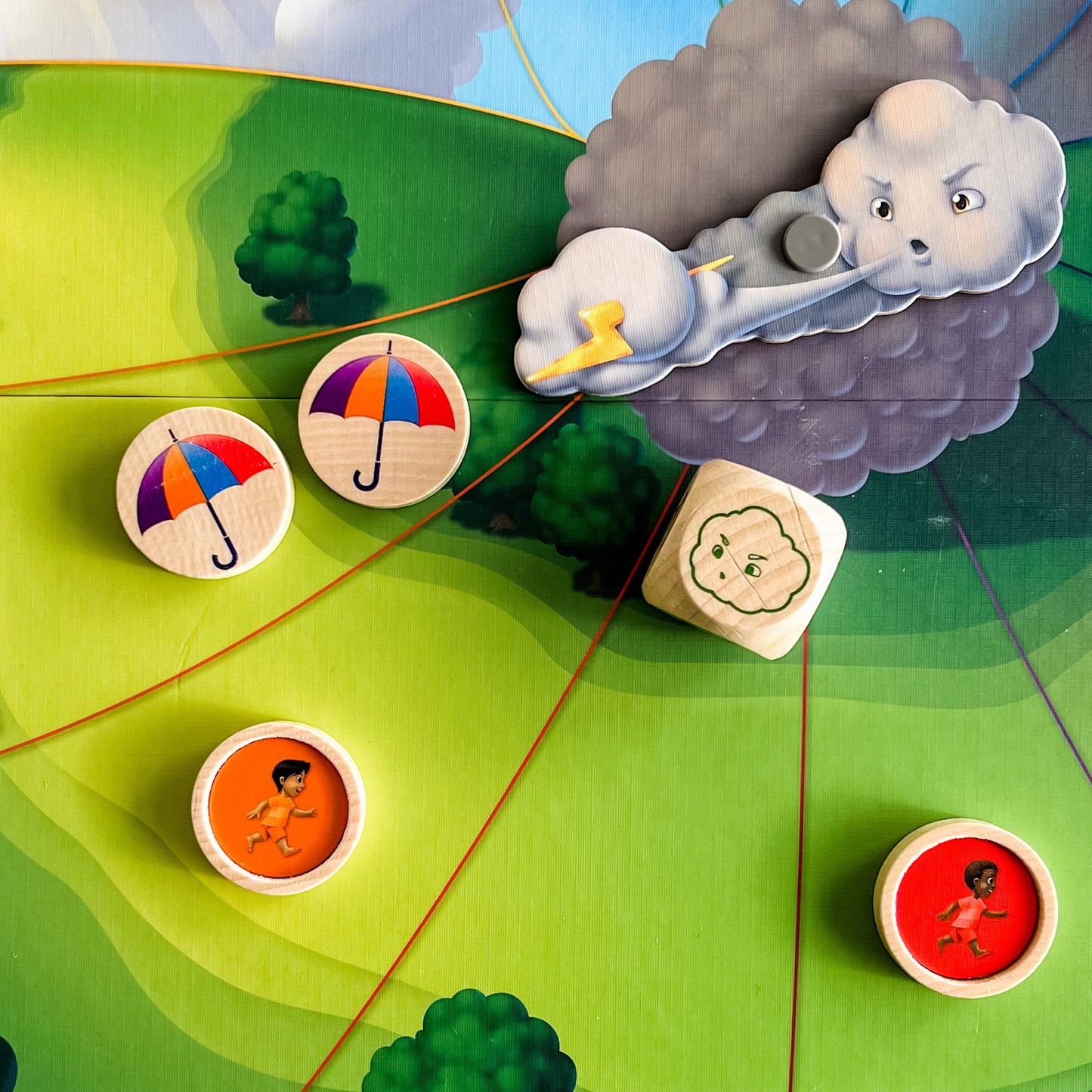
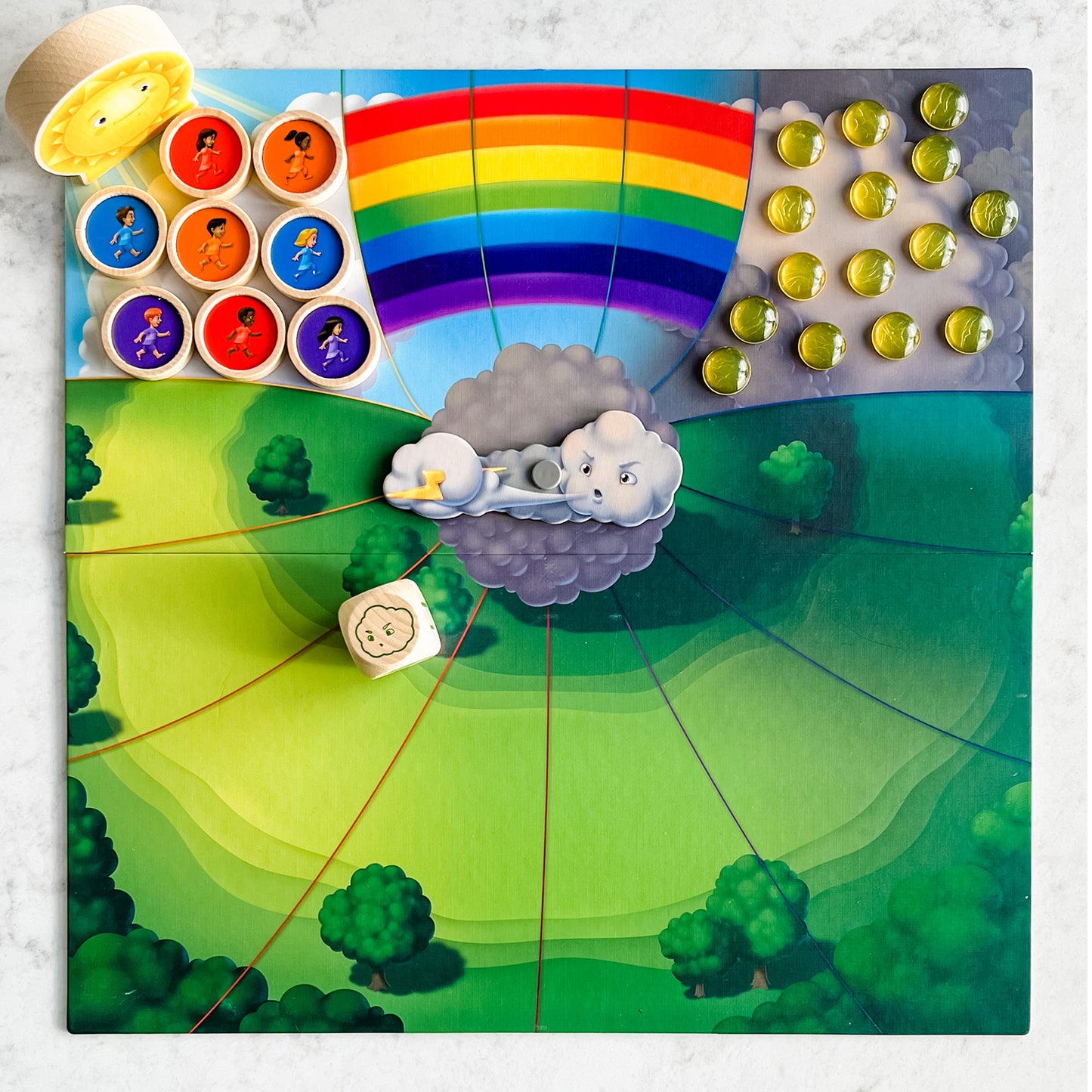
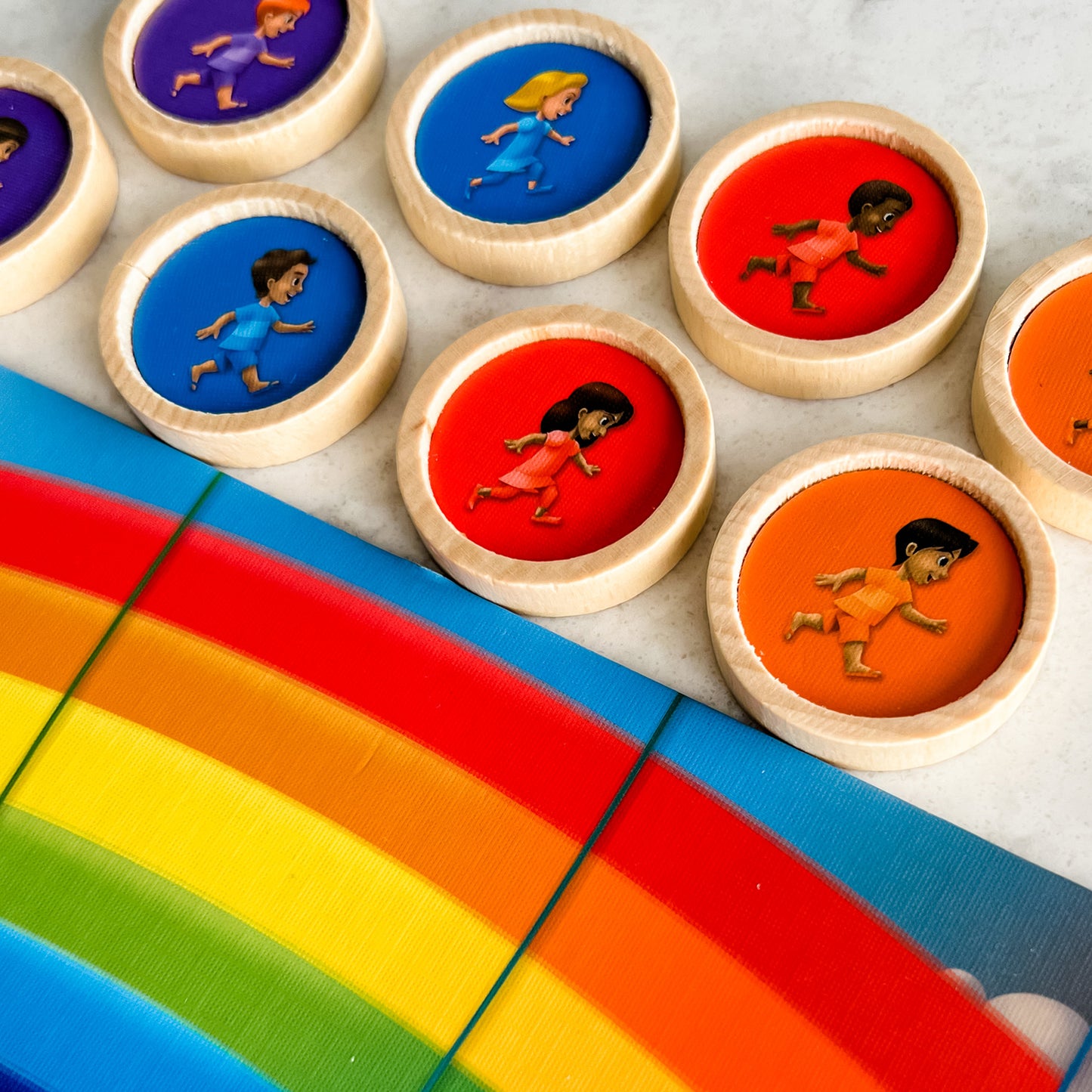

Collapsible content
How to Play
Educational Standards
Core Standard*: Math
Math
- Mathematical Practice
- Model with mathematics. Grades 2 & 3
Skills
Explore
What Does Child Do To Use Skill In The Game?
Sunshine Rescue involves a little exploration as players observe the movement of Children Tokens and the Sun.
How Parents Can Assist Learning
Parents may need to remind children that the Sun and their Children Tokens can move forward and backwards. This will help younger players explore the game board more carefully.
Learning Implications and Educator Support
Sunshine Rescue helps children develop directionality, situational analysis and risk assessment.
Educators can encourage children to think about whether to take the Rainbow Shortcut or not, and when in the game is it better to take or avoid the Shortcut.
Determine
What Does Child Do To Use Skill In The Game?
On their turn, players determine where to move the Sun or one of their Children Tokens based on the role of the die.
How Parents Can Assist Learning
Parents may need to remind children that the Sun and their Children Tokens can move forward and backwards. This will help younger players explore the game board more carefully.
Encourage children to think about whether to take the Rainbow Shortcut or not. Ask this at different times in the game, as the answer may change based on the circumstances.
Learning Implications and Educator Support
Sunshine Rescue helps children develop directionality, situational analysis and risk assessment.
Educators can encourage children to think about whether to take the Rainbow Shortcut or not, and when it the game is it better to take or avoid the Shortcut. Also, you may need to remind children that the Sun and their Children Tokens can move forward and backwards. This will help younger players explore the game board more carefully.
Remember
What Does Child Do To Use Skill In The Game?
There is a little short term memory in Sunshine Rescue as players need to remember which Umbrella is covering their Children Token(s).
How Parents Can Assist Learning
For young players, encourage them to place their Umbrella in the same location on any path area. For example, place it close to the storm area or at the very edge of the game board.
Learning Implications and Educator Support
For young players, encourage them to place their Umbrella in the same location on any path area. For example, place it close to the storm area or at the very edge of the game board.
Predict
What Does Child Do To Use Skill In The Game?
Players need to make a risk and determination whether to move a Children Token across the Rainbow Shortcut. This involves predicting whether they think the token can move across the Shortcut before Storm Cloud Spinner lands on it.
How Parents Can Assist Learning
After they role the die, encourage children to "Wait. Look. Think."
Help them think about whether to take the Rainbow Shortcut or not by asking questions like "Who is currently winning the game? How likely is it that you will make it across safely? Can you take the risk of not making it across?"
Learning Implications and Educator Support
Sunshine Rescue is a good game for introducing basic predicting, probability and risk-reward analysis as children consider whether to take the Rainbow Shortcut or not.
Educators can help children think about whether to take the Rainbow Shortcut by asking questions like "Who is currently winning the game? How likely is it that you will make it across safely? Can you take the risk of not making it across?"
Plan
What Does Child Do To Use Skill In The Game?
Players may try to plan their path to collecting Pieces of Sunshine. However, the Storm Cloud adds significant randomness that limits planning.
How Parents Can Assist Learning
Adaptability, resilience and persistence are important life skills that are enhanced playing Sunshine Rescue.
If a player's Children Token is affected by the Storm Cloud, encourage them to stay positive and think about what they can do on future turns to get their Children Token turned right side up or move other Tokens to secure a Piece of Sunshine.
Learning Implications and Educator Support
Adaptability, resilience and persistence are important life skills that are enhanced playing Sunshine Rescue.
If a player's Children Token is affected by the Storm Cloud, encourage them to stay positive and think about what they can do on future turns to get their Children Token turned right side up or move other Tokens to secure a Piece of Sunshine.
Experiment
What Does Child Do To Use Skill In The Game?
Players may experiment with moving Children Tokens across the Rainbow Shortcut.
How Parents Can Assist Learning
If a child tries moving their Children Tokens across both the Rainbow Shortcut and the Field, discuss the results of each approach. This will help you understand what they are learning by experimenting with different approaches.
Learning Implications and Educator Support
If a child tries moving their Children Tokens across both the Rainbow Shortcut and the Field, discuss the results of each approach. This will help you understand what they are learning by experimenting with different approaches.
Solve
What Does Child Do To Use Skill In The Game?
Players need to adapt to their Children Tokens being turned over if the Storm Cloud lands on their space or the Rainbow Shortcut. Also, they are changing strategies and decisions based on where their opponent's tokens are located.
How Parents Can Assist Learning
Children may need to be reminded that their tokens and the Sun can move forwards and backwards. Additionally, encourage them to keep track of where their opponent's tokens are and how many Pieces of Sunshine they have collected or are carrying.
Learning Implications and Educator Support
Sunshine Rescue involves directionality, if/then problem solving, risk and reward problem solving, and adaptability.
Children may need to be reminded that their tokens and the Sun can move forwards and backwards. Additionally, encourage them to keep track of where their opponent's tokens are and how many Pieces of Sunshine they have collected or are carrying.
*Data compiled from CCSSI ELA Standards, WA Science Standards, and Washington Social Studies Standards
Special Needs
Cognitive
Suggestions for How to Modify Play Experience
Children with cognitive challenges may need the game to be simplified. One way to simplify is to allow the players to go back with sunshine through the Rainbow Shortcut. This carries the risk of loss of the sunshine, but it is a faster path with a quicker reward.
To simplify the game and make choice of moves less complicated, eliminate the use of the umbrella side of the Children tokens. When the Storm Cloud points to the player's Child, the player must either go back two spaces or dump their Piece of Sunshine if carrying one. This eliminates the need for the Sun piece and makes the game more straight forward.
Communication
Suggestions for How to Modify Play Experience
No discussion is required to play Sunshine Rescue, but players will comment on each others' moves of the Sun and Children Tokens, as well as spinning of the Storm Cloud. Encourage the child with communication issues to make comments after each turn. For example, "Jordan just brought home a Piece of Sunshine. How many more does he need to rescue to have 3 pieces?"
Sensorimotor
Suggestions for How to Modify Play Experience
Sunshine Rescue requires moving tokens, turning tokens over, spinning the Storm Cloud spinner, picking up small Pieces of Sunshine and placing them on tokens, and dumping these Sunshine Pieces. Children with fine motor difficulties may struggle with manipulating the pieces. Allow the child to do what they can do independently, for instance, slide their Children Tokens along the spaces. Then have the child instruct other players what to do to help them with the moves that are difficult. For example, "Can you spin the Storm Cloud for me, please?"
Social Emotional/Behavioral
Suggestions for How to Modify Play Experience
Sunshine Rescue is straight forward and moves quickly. This may make it a good game for children who are impulsive or have difficulty attending.
For children who have low frustration tolerance or get angry easily, losing a Piece of Sunshine they have worked hard to obtain may be difficult. Help the child learn how to build resilience by helping them plan the next moves to recover their position in the game. For example, "It made you mad to lose that Piece of Sunshine. Let's think about what we can do to get it back! How far away is the Sun? The Sun can rescue you and then you can retrieve your Sunshine!" Helping children review and plan in games teaches them to manage emotions.
Vision
Suggestions for How to Modify Play Experience
Depending on the child's level of vision, Sunshine Rescue can be played by some children with low vision. The orange and red, and blue and green Children Tokens may be difficult to differentiate. If this is the case, use a black marker to outline the edge of two tokens. These will always be the tokens used by the child with vision issues. Also use a black marker or a bright contrasting marker color to trace over the lines on the board demarking the spaces on the board.
Encourage children with low vision to move their tokens on the outer edges of the board. These parts of the spaces have more contrast and are thus easier to see.
Hearing
Suggestions for How to Modify Play Experience
Children with hearing impairments may be encouraged to participate in discussions during play by using sign language or other assistive devices.
*Data compiled from CCSSI ELA Standards, WA Science Standards, and Washington Social Studies Standards
Autism
Autism Strengths & Interests
Short Summary of Strengths & Interests
- Memory for hidden pictures.
- Ability to make decisions.
- Fine motor skill.
Is good at matching visual items
This game is not appropriate
Has a good memory for sensory details, including visual, touch, taste and smell
This game is not appropriate
Has a good memory for words, phrases and dialouge
This game is not appropriate
Has a good memory for pictures, numbers and patterns
Is This Game Appropriate? Yes
Description
When the Children Tokens are turned over, all Umbrellas look the same. Players must remember which Umbrella is their token.
Likes to put things in order or a sequence
This game is not appropriate
Learns through visualizing or "replaying" actions in their mind
Is This Game Appropriate? Yes
Description
Players may benefit from remembering their own or others actions in previous turns.
Likes activities with rules, such as math and phonics
This game is not appropriate
Is very concrete and literal
Is This Game Appropriate? Yes
Description
Sunshine Rescue is concrete and literal. The game is easy to follow and played the same way each time. Children will like the small shiny Pieces of Sunshine their tokens carry back to the sunny corner. Additionally, players move only one to four spaces or spin a thunder cloud on their turn.
Learns in small "chunks" (for example, phone numbers are 3 chunks of number xxx-xxx-xxxx that are combined together)
This game is not appropriate
Is good at nonverbal reasoning and logic
Is This Game Appropriate? Yes
Description
Sunshine Rescue involves determining which piece to move and in which direction in order to collect Pieces of Sunshine or turn over your Umbrella, and possibly the Umbrellas of other players. Logic, spatial reasoning and directionality are involved in making this decision.
Likes spatial problem solving
Is This Game Appropriate? Yes
Description
A minimal amount of spatial reasoning is involved, as children must decide what path to take, whether to rescue a dropped Piece of Sunshine or move on to the stormy corner.
Can read well with good vocabulary, though may not fully comprehend content
This game is not appropriate
Likes to use and has good fine motor skill
Is This Game Appropriate? Yes
Description
Fine motor skills are needed to pick up, turn over, and spin the various pieces in the game.
Likes established routines or set ways of doing things
Is This Game Appropriate? Yes
Description
The game is easy to follow and played the same way each time.
Likes manipulating, constructing or building things
Is This Game Appropriate? Yes
Description
Children have the opportunity to manipulate the tokens, sunshine drops, and cloud spinner.
Likes to use and has good musical abilities
This game is not appropriate
Likes to use and has good drawing skills
This game is not appropriate
Autism Special Considerations
Appears to ignore other's communication and/or has difficulty giving eye contact to a communication partner
Is This Game Appropriate for Child with Characteristic? Yes
Can Child with Characteristic Play Game w/o Modification? Yes
Strategies for Developing Compensatory Skills:
Players do not have to listen to or watch other's players to focus on the game. Players can focus on the board and the moves made by other players.
Has difficulty understanding complex verbal directions
Is This Game Appropriate for Child with Characteristic? Yes
Can Child with Characteristic Play Game w/o Modification?Yes
Strategies for Developing Compensatory Skills:
Directions to Sunshine Rescue are not complex, but the Children Tokens do have two sides. Children have to understand the meaning of both sides of the token and make the appropriate moves with each side. For some children this may be confusing and too complicated. If this is the case Sunshine Rescue may not be a good match.
Uses vocabulary inaccurately or demonstrates echolalia (repeating another's speech)
Is This Game Appropriate for Child with Characteristic? Yes
Can Child with Characteristic Play Game w/o Modification? Yes
Strategies for Developing Compensatory Skills:
Sunshine Rescue does not require intense focus, so echolalic or repetitive speech should not interfere with play.
Gets stuck repeating a verbal topic or physical actions and/or has difficulty attending to others' actions or topic.
Is This Game Appropriate for Child with Characteristic? Yes
Can Child with Characteristic Play Game w/o Modification? Yes
Strategies for Developing Compensatory Skills:
Many children with autism have perserverative (repetitive) non-meaningful actions, such as flapping their hands. These behaviors may be distracting to other players, but should not interfere with the game if the child can still focus during their turn. If the behaviors are extreme they may prohibit the child or other players from focusing on the game. If this is the case, Sunshine Rescue is not an appropriate game.
Has difficulty producing speech/communication
Is This Game Appropriate for Child with Characteristic? Yes
Can Child with Characteristic Play Game w/o Modification? Yes
Strategies for Developing Compensatory Skills:
Players do not have to talk during Sunshine Rescue, but interaction and communication should be encouraged. Comment on each others' turns and the consequences of the spinning of the Storm Cloud. Ask simple questions to encourage the child to respond.
Has difficulty sequencing multi-step actions and/or doing complex abstract tasks
Is This Game Appropriate for Child with Characteristic? No
Can Child with Characteristic Play Game w/o Modification? No
Strategies for Developing Compensatory Skills:
Sunshine Rescue involves moving Children Tokens across the board to gather Pieces of Sunshine. If, however, the Storm Cloud points to the player's Token, the child must turn it over to the Umbrella side.
If the Token is carrying a Piece of Sunshine, this is dropped, and other players can pick it up. The Umbrella side can only be returned to the Children side if the Sun comes to the player's Token or the Token is moved to the Sun. This sequence requires the child to understand the meaning of the Storm Cloud and the need for the Sun piece to be played. The effects of different components of the game may make Sunshine Rescue too complex for some children with autism. Children who are higher functioning, however, may be able to comprehend the various aspects of the game.
Demonstrates difficulty initiating and maintaining social interactions
Is This Game Appropriate for Child with Characteristic? Yes
Can Child with Characteristic Play Game w/o Modification? Yes
Strategies for Developing Compensatory Skills:
Children do not need to have social interactions during the game. Players can be encouraged, however, to watch and comment on other's moves. For example, when other players groan about the Storm Cloud and causing them to lose their Sunshine Piece or hide under their Umbrella, help the child respond to the other player's feelings. "Did you hear that groan? How do you think she feels?" You can also point out opportunities to rescue Pieces of Sunshine dropped by other players. Prompt the child to comment. "Tell him, I'm coming for your sunshine!" This helps the child pay attention to and comment on their own and others' moves.
Acts out or demonstrates avoidance behaviors when frustrated, overwhelmed, or needs more sensory input.
Is This Game Appropriate for Child with Characteristic? Yes
Can Child with Characteristic Play Game w/o Modification? No
Strategies for Developing Compensatory Skills:
Discussions with just one or two peers or adults may be less overwhelming for children with autism. Keep discussion short.
Make sure the place for the discussion is quiet, with few distractions.
Allow the child to have a fidget toy or something to manipulate. This sometimes help the child focus and work off any anxiety.
Has short attention span for non-preferred activities
Is This Game Appropriate for Child with Characteristic? Yes
Can Child with Characteristic Play Game w/o Modification? No
Strategies for Developing Compensatory Skills:
Talking in groups is challenging for children with autism. Unless the child topic being discussed is relevant or of interest, maintaining the child's attention and involvement will be difficult. Give the child choices of questions to ensure interest.
Needs sameness or consistent routines and/or has difficulty with transitions from one activity to another
Is This Game Appropriate for Child with Characteristic? Yes
Can Child with Characteristic Play Game w/o Modification? Yes
Strategies for Developing Compensatory Skills:
Has difficulty understanding others' feelings, intentions, and the reasons for others' actions.
Is This Game Appropriate for Child with Characteristic? No
Can Child with Characteristic Play Game w/o Modification? No
Strategies for Developing Compensatory Skills:
Many of the questions in Tween What If? Involve seeing others' perspectives, feeling, intentions, etc. This is challenging for children with autism, but also is an important skill to practice. Structured practice using the cards may help the child gain insight into others needs. Start with simple questions and move into more difficult ones.
Making the abstract question more concrete can help the child focus. Use a picture cue or object to redirect the child. For example, for the question, "What if my friends are doing something I think is mean or bad?" use a picture of two people who are angry or act out the situation for the child to see.
Prompt the child for each step of a solution. "How would you feel?" "What could you say to let the person know how you feel?" "What else could you do?"
Use examples from books or movies that the child likes to illustrate a situation that is related to the question. "Remember in the movie..... when the bully at school called him a doofus? What happened? What would have been better?" Others can then build on the child's response.
*Data compiled from CCSSI ELA Standards, WA Science Standards, and Washington Social Studies Standards
Extended Play
Extra Ways to Play the Game
Allow the players to bring the Pieces of Sunshine back through the rainbow.
Materials Needed
No additional materials required.
Developmental Benefits
This option increases the risk-reward potential of the game. Children may be able to win more quickly, but theyincrease the risk losing their Sunshine.
Extra Ways to Play the Game
Play the game with partners. Each team gets two rolls of the die per turn. They must decide together what move to make with each Children Token.
Materials Needed
No additional materials required.
Developmental Benefits
Playing with a partner encourages children to talk, share opinions, and negotiate a decision about how to play. This teaches cooperation and seeing another's perspective.
*Data compiled from CCSSI ELA Standards, WA Science Standards, and Washington Social Studies Standards
Collapsible content
How to Play Video & Transcript
Pieces of sunshine are trapped on the stormy corner and the sun needs help! It’s children to the rescue with Simply Fun’s Sunshine Rescue.
You can play Sunshine Rescue with 2 to 4 players ages 7 and up.
Sunshine Rescue helps players learn to make good decisions, as they decide between moving carefully or taking risks to advance more quickly.
Sunshine Rescue also helps players learn to work together to achieve their goals.
To set up Sunshine Rescue, place the game board in the center of the table. Press it flat so the spinner can spin easily and is pointed at the sunny corner.
Place the 15 pieces of sunshine on the stormy corner. Each player chooses a color, receives that pair of child player pieces, and then places them on the sunny corner. This is the starting space.
Place the sun on the sunny corner as well. Now we’re ready to rescue!
The object of Sunshine Rescue is to be the first to player to rescue three pieces of sunshine and bring them back to the sunny corner.
To begin the game, the first player rolls the die.
On the die, there are NUMBERS, for moving player pieces and the sun, and THE STORM CLOUD, which causes player pawns to hide under their umbrellas.
If a NUMBER is rolled, they must take one of the following actions:
Action 1: Move one child the full number of spaces rolled
• Players may choose one of their children to move - you may move a different child each turn.
• Players may choose which path to take – If a child is not carrying a piece of sunshine, then they may move either through the field or through the rainbow shortcut. If a child is holding a piece of sunshine, then they can only take the path through the field.
• Players must stop when they enter the stormy or sunny corner, even if they have not moved the full number rolled on the die.
• If a player stops on the stormy corner, or onto another space that has a piece of sunshine on it, that child may pick up the piece of sunshine when they leave that space on their next turn.
Action 2: Move any umbrella one space toward the sunny corner or the sun.
• You may not peek under the umbrella, so it’s ok if you move another players pawn.
• Umbrellas can travel on either the rainbow shortcut or the path through the field.
• If the umbrella stops on the sunny corner or on a space with the sun, congratulations! Flip the pawn over so the child side is showing. Now you get a bonus turn for saving the child and can roll again!
Action 3: Move the sun the number of spaces rolled toward an umbrella.
The sun is shared by all players and can be moved around the path through the field by any player. Use the sun pawn to rescue children hiding under umbrellas or to protect yourself as you carry pieces of sunshine along the path through the field.
• The sun may only travel on the path and into the sunny corner; it may never enter the stormy corner or the rainbow shortcut.
• If the sun stops on a space with an umbrella, congratulations! Flip over all the umbrellas on that space so all the children are showing. Now you get a bonus turn for saving the children and can roll again!
If the player rolls a storm cloud, they must first spin the spinner before moving a child of their choice one space. If they are caught by the storm cloud, the children must hide under their umbrellas. Any children that flip over to umbrellas immediately drop their piece of sunshine onto their current space, if they have one.
• If the storm cloud points to any space on the field, or points at the stormy corner, all the children on that exact space must flip over to umbrellas.
• If the storm cloud points to any space on the rainbow shortcut, then ALL children anywhere on the rainbow must flip over to umbrellas.
• If the storm cloud points to an empty space, the children are lucky and nothing happens.
• Any children hiding under their umbrellas must remain hidden until they are rescued by the sun or by traveling to the sunny corner.
After spinning the spinner and flipping over any pawns, the player may move one child, one umbrella or the sun one space. If you were able to rescue any children, then you get a bonus turn!
Once a turn is over, wherever the storm cloud is pointing remains stormy until the storm cloud is spun again. Due to this, players should avoid stopping in a stormy spot or else they will have to hide under their umbrellas.
Play continues with the next player.
The first player to rescue three pieces of sunshine by returning them to the sunny corner wins the game!
Rescue pieces of sunshine and rescue children from the storm cloud with Simply Fun’s Sunshine Rescue!
- Choosing a selection results in a full page refresh.
- Opens in a new window.

